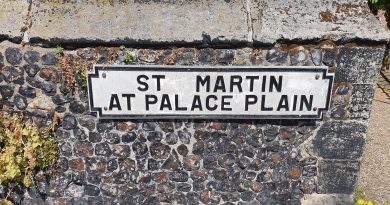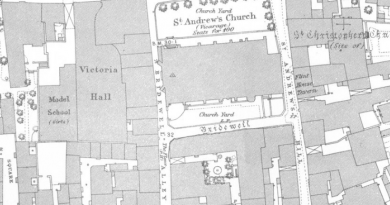Norwich – St. Ethelbert’s Gate
St. Ethelbert’s Gate is one of the two main entrances to Norwich Cathedral close, the other being the Erpingham Gate. It was first constructed in 1316, but the reason for its being dates back to the thirteenth century.
It’s fair to say that the monks in the cathedral didn’t entirely always get on with the ruffians that formed the population of Norwich at the time. There was a busy market at Tombland, which was perhaps quite raucous from time to time with its fairs and parties.
At this time, the church was also powerful and the monks were conscious that they exerted significant influence. The fairs had been established for the financial benefit of the monks and there were three per year, but instead, the city residents used them to amuse themselves by “displaying goods and animals”. This wasn’t really what the monks had wanted and there’s some suggestion that the residents of the city were trying to best to irritate the monks as best they could.
Arguments aside, this was all going marvellously until 1272 when the monks managed to kill some Norwich residents, which perhaps wasn’t their best idea. The legal system swung into action, but the church had consistory courts (on a side note, Norfolk Record Office still have the papers from these courts and they’re well worth looking at) and so they were quite content for, well, the monks to deal with the action of the monks.
The population of Norwich didn’t take well to this little arrangement, so they argued about it with the monks, who promptly locked the city gate. Perhaps the monks may have got away with this if it wasn’t for them employing mercenary soldiers who were accused of amusing themselves by firing at passers-by. To be fair, if I was walking in Tombland and was attacked by a representative of a monk, I would have been displeased.
And, the people of Norwich showed their displeasure in quite a violent way. They set fire to the whole cathedral and its attached buildings, causing significant damage to the structure and destroyed buildings such as St. Ethelbert’s church. They also pinched the nice things of the cathedral, such as vestments, they damaged books and killed some monks, with some other monks fleeing.
I’ve never found that violence such as this is the answer, whatever the population of the city might have thought at the time. But anyway, in 1272 Norwich isn’t looking in the best of shapes at this time. There’s now a burnt-out cathedral, angry monks, angry residents and a not inconsiderable amount of tension in the air. It was time for King Edward I to come to Norwich to see what his subjects were getting up to.
King Edward I, by most accounts, wasn’t best pleased. He blamed the city’s residents, which was perhaps more tied in with the power and influence of the church, but that’s a different matter. He fined the wealthy of the city and for the riff-raff, or “the inferior sort” as they were termed at the time, well, he just executed some of them. To balance things out a bit, he imprisoned some of the monks (although not for long, he was already worried about the Pope not being happy) and ordered that everyone should now try and get on. He actually just installed wardens to supervise the matter, but the intention was that everyone should get on.
To try and resolve the situation that now existed, in 1275, it was decided that there had to be some financial payments made to settle the matter. This included the construction of a new gate, since the city dwellers had smashed the old one down, and it was to be dedicated to St. Ethelbert since the church with this dedication had also been knocked down.
And here’s what they built, with everything finished off nicely in 1316. Looking out towards Tombland, the room above the gateway was once used as a chapel but is now a classroom that I’ve visited several times. The entire structure was repaired in 1815 under the supervision of William Wilkins, an architect who also built the city’s new prison in the castle.
The Lierne vaulting on the roof of the gateway, with the walls on either side looking somewhat battered now. Unfortunately, the location of the gate means that it has to remain open for road traffic, with pedestrians pushed towards the sides. On the left-hand side is a doorway which is an entrance to the room above, although another more practical set of stairs has been constructed which reaches the room from the next-door building.
Incidentally, the monks and the city residents didn’t settle their differences and the arguments persisted for decades. But at least the monks had a lovely new gate to use, and it’s a fine structure which the city is still fortunate to have. So something positive came from the rioting.







